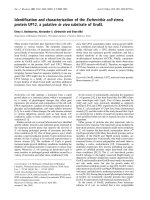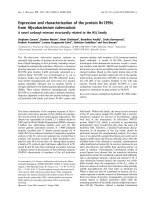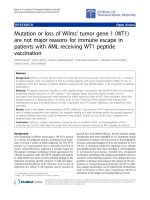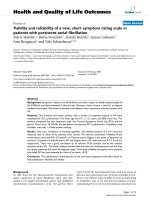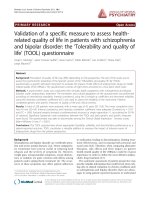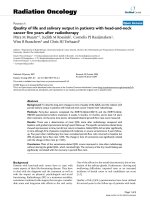Characterization of the rs2802292 SNP identifies FOXO3A as a modifier locus predicting cancer risk in patients with PJS and PHTS hamartomatous polyposis syndromes
Bạn đang xem bản rút gọn của tài liệu. Xem và tải ngay bản đầy đủ của tài liệu tại đây (418.41 KB, 6 trang )
Forte et al. BMC Cancer 2014, 14:661
/>
RESEARCH ARTICLE
Open Access
Characterization of the rs2802292 SNP identifies
FOXO3A as a modifier locus predicting cancer risk
in patients with PJS and PHTS hamartomatous
polyposis syndromes
Giovanna Forte1, Valentina Grossi2,3, Valentina Celestini2, Giuseppe Lucisano4, Marco Scardapane4, Dora Varvara2,
Margherita Patruno2, Rosanna Bagnulo2, Daria Loconte2, Laura Giunti5, Antonio Petracca6, Sabrina Giglio6,
Maurizio Genuardi7, Fabio Pellegrini4,8, Nicoletta Resta2 and Cristiano Simone2,3*
Abstract
Background: Hamartomatous polyposis syndromes (HPS) are inherited conditions associated with high cancer risk.
They include the Peutz-Jeghers and the PTEN hamartoma tumor syndromes, which are caused by mutations in the
LKB1 and PTEN genes, respectively. Estimation of cancer risk is crucial in order to optimize surveillance, but no
prognostic markers are currently available for these conditions. Our study relies on a ‘signal transduction’ hypothesis
based on the crosstalk between LKB1/AMPK and PI3K/PTEN/Akt signaling at the level of the tumor suppressor
protein FoxO3A. Interestingly, the FOXO3A rs2802292 G-allele was shown to be associated with longevity, reduced
risk of aging-related diseases and increased expression of FoxO3A mRNA.
Methods: We typed rs2802292 in 150 HPS unrelated patients and characterized the expression of FoxO3A by
quantitative PCR and immunoblot analysis in human intestinal cell lines.
Results: We found a significantly higher risk for malignancies in females and TT genotype carriers compared to
patients having at least one G-allele. Subgroup analysis for each HPS syndrome revealed a G-allele-associated
beneficial effect on cancer risk occurring mainly in males. Molecular characterization of human intestinal cell lines
showed that the G-allele significantly correlated with increased basal expression of FoxO3A mRNA and protein.
Conclusion: Our results suggest an inverse correlation between the protective allele (G) copy number and cancer
risk, and might be useful to optimize surveillance in HPS patients. Further investigations are needed to confirm our
hypothesis and to ascertain whether differences in therapeutic response exist across genotypes.
Keywords: Hamartomatous polyposis syndromes, PJS, PHTS, FOXO3A, Cancer risk
Background
Hamartomatous polyposis syndromes (HPS) - PeutzJeghers syndrome (PJS), PTEN hamartoma tumor syndrome (PHTS) and juvenile polyposis syndrome (JPS) - are
inherited conditions showing hamartomatous polyp histology and increased risk of cancer during lifetime.
* Correspondence:
2
Division of Medical Genetics, Department of Biomedical Sciences and
Human Oncology (DIMO), Università di Bari “Aldo Moro”, Policlinico, Piazza
Giulio Cesare 11, 70124 Bari, Italy
3
National Cancer Institute, IRCCS Oncologico Giovanni Paolo II, 70124 Bari, Italy
Full list of author information is available at the end of the article
Hamartomatous polyps originate from uncontrolled proliferation of stromal cells and represent a small fraction of
all polyps arising in the GI tract [1].
PJS is an autosomal dominant disease with an estimated
prevalence of 1/8,300 to 1/200,000, and is characterized by
the presence of mucocutaneous pigmentation, hamartomatous polyps and an increased risk of cancer at different
sites (breast, GI tract, gynecological tumors) [2]. PJS is
caused by mutations in the LKB1 tumor suppressor gene,
which encodes a serine/threonine kinase [3].
PHTS has a prevalence estimate of 1/200,000 and comprises a group of phenotypically diverse rare autosomal
© 2014 Forte et al.; licensee BioMed Central Ltd. This is an Open Access article distributed under the terms of the Creative
Commons Attribution License ( which permits unrestricted use, distribution, and
reproduction in any medium, provided the original work is properly credited. The Creative Commons Public Domain
Dedication waiver ( applies to the data made available in this article,
unless otherwise stated.
Forte et al. BMC Cancer 2014, 14:661
/>
dominant conditions including Cowden syndrome (CS)
and Bannayan-Riley Ruvalcaba syndrome (BRRS) [4].
These are caused by germline mutations in the PTEN
tumor suppressor gene, which encodes a phosphatase.
Hamartomatous tumors can affect any organ, namely
skin, mucosal membranes, GI tract and other organs in
CS, and GI tract in BRRS, which is also associated with
macrocephaly, lipomatosis, and pigmented macules of
the glans penis. PHTS shows an increased risk of malignancies of the breast, colorectum, thyroid, kidney and
endometrium [5].
Several reports estimated cancer risk in HPS. PJS and
PHTS patients show a time-dependent high risk of malignancies, with females displaying a significantly higher
risk than males mainly due to the occurrence of breast
and gynecological tumors [2,4].
Estimation of cancer risk is crucial in order to implement risk-reducing measures, including intensive surveillance, lifestyle changes, chemoprevention or even
prophylactic surgery. However, there is currently no
available marker that can predict which HPS patients
will develop a malignancy and the age at which surveillance should be started. Recently, genetic modifiers have
been shown to play a role in determining cancer risk in
other mendelian tumor syndromes, such as BRCA1/2related breast and ovarian cancer, [6,7] and SNP genotyping could be of help in identifying a ‘modifier locus’
to predict the risk of cancer in HPS patients.
Our study is based on a ‘signal transduction’ hypothesis, which relies on the crosstalk between LKB1/AMPK
and PI3K/PTEN/Akt signaling at the level of FoxO3A
(Figure 1). In particular, LKB1 activates AMPK, which in
turn activates FoxO3A, while PTEN inhibits Akt, which
in turn inhibits FoxO3A [8]. Recently, it was found that
the FOXO3A locus strongly correlates with the longevity
phenotype in genetically diverse groups of European and
Asian descent [9-13]. Of note, the FoxO3A rs2802292
G-allele (minor allele count/MAF = 0.449/978) [14] was
shown to be associated with longevity in all populations
tested, [9-13] and its copy number correlated with reduced frequency of aging-related diseases, including cancer, in centenarians [9]. At the molecular level, the
rs2802292 G-allele displayed significant correlation with
increased basal expression of FoxO3A mRNA in muscle
biopsies of twins, suggesting that the second intron of
the FOXO3A locus, which contains the rs2802292 SNP,
may act as a regulatory sequence [15].
These data suggest that the rs2802292 G-allele could
enhance the well-known metabolic and anti-aging activities of FOXO3A by increasing gene expression. Indeed,
FoxO3A plays a role in proliferation/arrest, survival/
death, metabolism and autophagy, and has been implicated in tumor suppression, regulation of energy metabolism and development in a number of tissues [8]. All
Page 2 of 6
Figure 1 Our study is based on a ‘signal transduction’
hypothesis, which relies on the crosstalk between LKB1/AMPK
and PI3K/PTEN/Akt signaling at the level of FoxO3A. In
particular, LKB1 activates AMPK, which in turn activates FoxO3A,
while PTEN inhibits Akt, which in turn inhibits FoxO3A.
these functions are mediated by the finely tuned activation
of a coordinated transcriptional program encompassing
genes involved in cell cycle, metabolism, autophagy, stress
resistance and cell death [8].
To ascertain whether the positive effect of the rs2802292
G-allele on FoxO3A activity could counteract the detrimental effects of imbalanced AMPK/Akt signals on
transformation and cancer progression in PJS and PHTS
tissues, we typed this polymorphism in a group of unrelated patients previously characterized for LKB1 or PTEN
mutations.
Methods
Participants
The FoxO3A rs2802292 SNP was analyzed in 150 HPS
unrelated patients with identified mutations in the PTEN
(84 patients) or LKB1 (66 patients) genes. PTEN or LKB1
mutation carriers were recruited through various Italian
cancer genetics clinics and fulfilled the diagnostic clinical
criteria for PJS or PHTS, [16,17] and/or they were carriers
of the familial disease-causing mutation. We obtained participants’ informed consent approved by the local ethical
committees (AOU Policlinico, 70124 Bari, Italy; Meyer
University Hospital, 50139 Florence, Italy) for publication
of the dataset at recruitment into the study in compliance
with international and national data protection laws. The
dataset is fully anonymous, as it does not contain any
direct or indirect identifier, thus respecting participants’
rights to privacy and protecting their identity.
Forte et al. BMC Cancer 2014, 14:661
/>
Cell culture and reagents
HT-29, Caco-2, LS174T, HCT-116 cells (all from ATCC)
were grown in DMEM supplemented with 10% FBS
(HT-29, LS174T and HCT-116) or 20% FBS (Caco-2),
100 IU/ml penicillin and 100 μg/ml streptomycin in a
humidified incubator at 37°C and 5% CO2 avoiding confluence at any time.
Genotyping
Genomic DNA from peripheral blood and cell lines was
extracted using QIAsymphony SP/AS instruments (QIAGEN) according to the manufacturer’s protocol and
quantified on a NanoDROP 2000 spectrophotometer
(Thermo Scientific). PCRs were carried out in 25 μl reaction mixtures containing 50 ng of genomic DNA, 1X
PCR Buffer (Tris–HCl, (NH4)2SO4, 15 mM MgCl2;
pH 8.7), 200 μM dNTPs and 0.5 U HotStarTaq DNA
Polimerase (QIAGEN) and the following primers (10
pmol each): FoxO3A rs2802292g/t Fw, cagcttctgagtgacagagtg and FoxO3A rs2802292g/t Rw, ttcttccctagagagcagcag. PCR amplification cycles were carried out at 95°C
for 15 min followed by 29 cycles of denaturation at 94°C
for 1 min, annealing at 60°C for 1 min and extension at
72°C for 1 min, and then a final extension at 72°C for
10 min on a GeneAmp PCR System 9700 thermocycler
(Applied Biosystems). 5 μl of the amplified products
were loaded onto 2% Agarose Standard Low EEO (AB
Analitica) in 0.5X TBE and visualized using GelRedTM
(Biotium, Hayward, CA). Sequencing products were
purified by use of the DyeEx™ 2.0 Spin Kit (QIAGEN,
Milan, Italy) and sequenced on an ABI PRISM 310 Genetic Analyzer (Applied Biosystems).
Quantitative real time PCR
Total RNAs were extracted using TRI Reagent (Sigma).
Samples were treated with DNase-1 (Ambion) and
retro-transcribed using the High Capacity DNA Archive
Kit (Applied Biosystems). PCRs were carried out using
the SYBR Green PCR Master Mix on an ABI 7500HT
machine (Applied Biosystems). Relative quantification
was done using the ddCT (Pfaffl) method. Primer sequences are available upon request.
Page 3 of 6
using anti-β-Actin (Sigma) and anti-FoxO3A (Cell Signaling). Western blots were developed with the ECL-plus
chemiluminescence reagent (GE Healthcare) as per manufacturer’s instructions.
Statistical methods
Patient characteristics were reported as medians and
interquartile range (IR), and frequency and percentages, for continuous and categorical variables, respectively. Characteristics were also stratified according to
the presence of malignant tumors, mutation type and
genotype, and compared using Pearson’s χ2 and Mann–
Whitney U tests for categorical and continuous variables, respectively. To account for potential confounding, presence of malignant tumors was analysed with
multivariate logistic regression models and the following covariates were included: gender, age at diagnosis
(in years) and genotype (TT and XG). Results were reported as odds ratios (ORs) along with their 95% confidence intervals (95% CI). Adjusted risks for each
variable employed in the models were also estimated.
Two-sided p-values < 0.05 were considered statistically
significant. All statistical analyses were performed
using SAS Statistical Package version 9.3 (SAS Institute, Cary, NC).
Results
A total of 150 patients were analyzed. Median age at
diagnosis was 18 (IR 1–77) years, females were 44.7%,
and patients with LKB1 and PTEN mutations were 56%
and 44%, respectively. Prevalence of the rs2802292 G-allele
was 45.3%, which is consistent with the MAF previously
described for the general population [14].
Overall cancer risk for our sample was 19.7%. Patient
characteristics according to the presence of malignancies
(see Table 1 for cancer locations) are shown in Table 2.
Patients with and without cancer tended to differ significantly in terms of gender, age at diagnosis and TT
Table 1 Tumor number and location in PJS and
PHTS patients
PHTS patients*
PJS patients**
Immunoblotting analysis
Thyroid
4
1
Immunoblotting analyses were performed according to
Cell Signaling’s instructions. Briefly, cells were homogenized in 1X lysis buffer (50 mM Tris–HCl pH 7.4; 5 mM
EDTA; 250 mM NaCl; 0.1% Triton X-100) supplemented
with protease and phosphatase inhibitors (1 mM PMSF;
1.5 μM pepstatin A; 2 μM leupeptin; 10 μg/ml aprotinin,
5 mM NaF; 1 mM Na3VO4). 15 to 20 μg of protein extracts from each sample were denatured in 5× Laemmli
sample buffer and loaded into an SDS-polyacrylamide gel
for western blot analysis. Western blots were performed
Breast
3
4
Gynecological tract
2
10
Kidney
2
0
Gastrointestinal tract
1
3
CNS
1
0
Other
1
0
Total
14
18
*2 patients with multiple tumors.
**3 patients with multiple tumors.
Forte et al. BMC Cancer 2014, 14:661
/>
Page 4 of 6
Table 2 Patients characteristics according to the presence
of malignant tumors
Malignant tumors
Variable
Category
n
Age
Genotype (2 levels)
Mutation
Sex
Benign tumors
G.I. benign tumors
Yes
106
26
p-value
48.00
0.001
(13.00-85.00)
17.00
(1.00-72.00)
24.50
(5.00-77.00)
0.0421
GG
28 (26.42)
5 (19.23)
0.1062
TG
48 (45.28)
8 (30.77)
TT
30 (28.30)
13 (50.00)
XG
76 (71.70)
13 (50.00)
TT
30 (28.30)
13 (50.00)
LKB1
56 (52.83)
16 (61.54)
PTEN
50 (47.17)
10 (38.46)
F
39 (36.79)
17 (65.38)
M
67 (63.21)
9 (34.62)
No
27 (25.47)
3 (11.54)
Yes
79 (74.53)
23 (88.46)
No
43 (40.57)
4 (15.38)
Yes
63 (59.43)
22 (84.62)
106 (100.00)
21 (80.77)
0 (0.00)
5 (19.23)
G.I. malignant tumors No
Yes
Parameter
Label
OR (95% CI)
P value
Sex
M VS F
0.23 (0.06-0.94)
0.0407
TT VS XG
2.82 (0.74-10.71)
0.1285
1.02 (0.97-1.06)
0.4816
Genotype (2 levels)
31.00
(3.00-78.00)
Age at diagnosis
Genotype
No
Table 4 Multivariate logistic regression model for the
presence of malignant tumors in PJS patients
0.0344
0.4242
0.0082
0.1287
0.0163
<0.0001
Data are expressed as medians and interquartile range, and frequency and
percentages, for continuous and categorical variables, respectively. P values
refer to Pearson’s χ2 and Mann–Whitney U tests for categorical and continuous
variables, respectively.
genotype. Results for case-mix (i.e. gender and age at
diagnosis) adjusted analyses are provided in Table 3. A
significantly higher risk of malignancies was found for
females (OR 3.33, 95% CI 1.32-8.33; p: 0.011) and TT
genotype carriers compared to patients having at least
one G-allele (XG) (OR 2.53, 95% CI 1.01-6.34; p:
0.048). This genotype-associated risk increase was
slightly greater in PJS (OR 2.82 95% CI 0.74-10.81; p:
0.128) than in PHTS (OR 2.14 95% CI 0.46-9.93; p:
0.332) (Tables 4 and 5). Furthermore, females carrying
at least one G-allele (XG) showed a cancer risk of 28%
Age at diagnosis
The model is adjusted for gender, age at diagnosis (in years) and genotype
(2 levels).
(95% CI 15-44%), which increased to 35% (95% CI 1758%) for TT females. Of note, only 6% (95% CI 2-16%)
of XG males had cancer, while the percentage rose to
25% (95% CI 12-47%) for TT male carriers. Subgroup
analysis for each syndrome revealed that the G-alleleassociated beneficial effect on cancer risk occurs
mainly in HPS males [PJS males with cancer: XG 7%
(95% CI 1-27%) vs TT 22% (95% CI 5-62%); PHTS
males with cancer: XG 4% (95% CI 0-27%) vs TT 28%
(95% CI 9-59%)]. Of note, PJS females carrying the TT
genotype were the subgroup with the highest cancer
rate [49% (95% CI 21–77)]. This latter result suggests
an inverse correlation between the copy number of the
protective allele (G) and the risk of cancer, which
would be consistent with the reduced frequency of
aging-related diseases, including cancer, observed in
centenarians [9].
To get insight into the molecular mechanism possibly
explaining the beneficial effect of the rs2802292 Gallele, we measured FoxO3A mRNA and protein levels
in human intestinal cell lines. Based on our results, cells
carrying the GG genotype (HCT-116, Caco-2) showed
significantly higher expression of FoxO3A mRNA and
protein compared to cells with the TT genotype (HT29, LS174T) (Figure 2). These data are in agreement
with the analysis performed in muscle biopsies of 190
twins indicating that the rs2802292 G-allele was associated with increased basal expression of FoxO3A
mRNA [15].
Discussion
None of the other parameters (mutation type, presence
of benign tumors and age at diagnosis) significantly
Table 3 Multivariate logistic regression model for the
presence of malignant tumors
Table 5 Multivariate logistic regression model for the
presence of malignant tumors in PHTS patients
Parameter
Label
OR (95% CI)
P value
Parameter
Label
OR (95% CI)
P value
Sex
M VS F
0.30 (0.12-0.76)
0.0114
Sex
M VS F
0.52 (0.11-2.42)
0.4038
TT VS XG
2.53 (1.01-6.34)
0.0484
Genotype (2 levels)
TT VS XG
2.14 (0.46-9.93)
0.3317
1.02 (0.99-1.04)
0.1797
Age at diagnosis
1.02 (0.99-1.06)
0.1917
Genotype (2 levels)
Age at diagnosis
Model is adjusted for gender, age at diagnosis (in years) and genotype
(2 levels).
The model is adjusted for gender, age at diagnosis (in years) and genotype
(2 levels).
Forte et al. BMC Cancer 2014, 14:661
/>
Page 5 of 6
Figure 2 GG genotype is associated with increased expression of FoxO3A both at the mRNA and protein level. HT-29, LS174T, HCT-116
and Caco-2 human intestinal cells were typed for the rs2802292 polymorphism and then analyzed by quantitative real-time PCR (A) and immunoblotting
(B) to measure FoxO3A mRNA and protein expression. β-Actin was used as a loading control.
influenced cancer risk in our cohort. These results are
of high interest because various research groups
throughout the world reported cancer risk estimates of
up to and over 80% for HPS patients by age 70 [2,4].
Based on our data, we speculate that HPS subjects carrying a GG genotype (which supposedly make up
around 20% of the overall HPS population) are less
likely to develop cancer or tend to be affected at an advanced age, while TT subjects develop malignancies
earlier in life and TG individuals show an intermediate
phenotype. Indeed, our ‘signal transduction’ hypothesis,
which proposed FoxO3A as the crossroad of the HPS
pathways LKB1/AMPK and PI3K/PTEN/Akt (Figure 1), is
supported by our finding that the GG genotype is associated with increased expression of FoxO3A both at the
mRNA and protein level (Figure 2). Regulation of FoxO3A
protein expression and localization is crucial for cancer
progression and treatment. Indeed, FoxO3A is downregulated in several neoplasms, [18] and inducing increased
FoxO3A expression levels is often sufficient to trigger its
transcriptional program in cancer cells leading to cell cycle
arrest, metabolic regulation and cell death [19].
Conclusions
Given the relatively small sample size and the crosssectional design of the study, we cannot exclude the
possibility of uncontrolled biases and residual confounding, which is why this hypothesis needs to be
confirmed on a higher number of patients and on
different populations, as well as through prospective
studies. These investigations will also be crucial to ascertain whether differences exist in terms of therapeutic response across genotypes and if mortality is
influenced by the rs2802292 allele in HPS subjects. Indeed, FoxO3A, which is a well-known tumor suppressor
gene, has emerged as a key downstream effector of various drugs used in tumor treatments, such as p38
inhibitors, cisplatin, paclitaxel, doxorubicin, imatinib,
PI3K-Akt inhibitors, EGFR/HER2 inhibitors, and ionizing radiation [8].
Abbreviations
HPS: Hamartomatous polyposis syndromes; PJS: Peutz-Jeghers syndrome;
PHTS: PTEN hamartoma tumor syndrome; JPS: juvenile polyposis syndrome;
CS: Cowden syndrome; BRRS: Bannayan-Riley Ruvalcaba syndrome.
Competing interests
The authors declare that they have no competing interests.
Authors’ contributions
GF, VG, VC, RB, DL, LG, DV, MP, and AP acquisition of data, technical
support. GL and MS statistical analysis; analysis and interpretation of data.
SG, MG, FP, and NR critical revision of the manuscript for important
intellectual content. CS study concept and design, analysis and
interpretation of data; drafting of the manuscript; study supervision.
All authors read and approved the final version.
Acknowledgements
We thank Dr Francesco Paolo Jori for his helpful discussion during the
preparation of the manuscript and editorial assistance, Drs Alessia Peserico
and Tugsan Tezil for technical assistance.
Funding
V.G. is supported by an Italian Association for Cancer Research (AIRC)
fellowship. This study was partially supported by FIRB – FUTURO IN RICERCA
RBFR12VP3Q_003 (to C.S.) from the Italian MIUR.
Author details
1
Cancer Genetics Laboratory, IRCCS ‘De Bellis’, Castellana Grotte, 70013 Bari,
Italy. 2Division of Medical Genetics, Department of Biomedical Sciences and
Human Oncology (DIMO), Università di Bari “Aldo Moro”, Policlinico, Piazza
Giulio Cesare 11, 70124 Bari, Italy. 3National Cancer Institute, IRCCS Oncologico
Giovanni Paolo II, 70124 Bari, Italy. 4Unit of Biostatistics, DCPE, Fondazione Mario
Negri Sud, Santa Maria Imbaro, 66030 Chieti, Italy. 5Medical Genetics Unit, Meyer
University Hospital, 50139 Florence, Italy. 6Dipartimento di Scienze Biomediche,
Sperimentali e Cliniche, University of Florence, 50139 Florence, Italy. 7Institute of
Medical Genetics, “A. Gemelli” School of Medicine, Catholic University, 00168
Rome, Italy. 8Unit of Biostatistics, Scientific Institute Casa Sollievo della
Sofferenza, San Giovanni Rotondo, 71013 Foggia, Italy.
Received: 15 April 2014 Accepted: 2 September 2014
Published: 11 September 2014
Forte et al. BMC Cancer 2014, 14:661
/>
References
1. Gammon A, Jasperson K, Kohlmann W, Burt RW: Hamartomatous polyposis
syndromes. Best Pract Res Clin Gastroenterol 2009, 23:219–231.
2. Resta N, Pierannunzio D, Lenato GM, Stella A, Capocaccia R, Bagnulo R,
Lastella P, Susca FC, Bozzao C, Loconte DC, Sabbà C, Urso E, Sala P,
Fornasarig M, Grammatico P, Piepoli A, Host C, Turchetti D, Viel A, Memo L,
Giunti L, Stigliano V, Varesco L, Bertario L, Genuardi M, Lucci Cordisco E,
Tibiletti MG, Di Gregorio C, Andriulli A, Ponz de Leon M, et al: Cancer risk
associated with STK11/LKB1 germline mutations in Peutz-Jeghers
syndrome patients: results of an Italian multicenter study. Dig Liver Dis
2013, 45:606–611.
3. Resta N, Simone C, Mareni C, Montera M, Gentile M, Susca F, Gristina R,
Pozzi S, Bertario L, Bufo P, Carlomagno N, Ingrosso M, Rossini FP, Tenconi R,
Guanti G: STK11 mutations in Peutz-Jeghers syndrome and sporadic
colon cancer. Cancer Res 1998, 58:4799–4801.
4. Bubien V, Bonnet F, Brouste V, Hoppe S, Barouk-Simonet E, David A, Edery P,
Bottani A, Layet V, Caron O, Gilbert-Dussardier B, Delnatte C, Dugast C,
Fricker JP, Bonneau D, Sevenet N, Longy M, Caux F, French Cowden Disease
Network: High cumulative risks of cancer in patients with PTEN
hamartoma tumour syndrome. J Med Genet 2013, 50:255–263.
5. Tan MH, Mester JL, Ngeow J, Rybicki LA, Orloff MS, Eng C: Lifetime cancer
risks in individuals with germline PTEN mutations. Clin Cancer Res 2012,
18:400–407.
6. Wang X, Pankratz VS, Fredericksen Z, Tarrell R, Karaus M, McGuffog L,
Pharaoh PD, Ponder BA, Dunning AM, Peock S, Cook M, Oliver C, Frost D,
EMBRACE, Sinilnikova OM, Stoppa-Lyonnet D, Mazoyer S, Houdayer C,
GEMO, Hogervorst FB, Hooning MJ, Ligtenberg MJ, HEBON, Spurdle A,
Chenevix-Trench G, kConFab, Schmutzler RK, Wappenschmidt B, Engel C,
Meindl A, et al: Common variants associated with breast cancer in
genome-wide association studies are modifiers of breast cancer risk in
BRCA1 and BRCA2 mutation carriers. Hum Mol Genet 2010, 19:2886–2897.
7. Gaudet MM, Kuchenbaecker KB, Vijai J, Klein RJ, Kirchhoff T, McGuffog L,
Barrowdale D, Dunning AM, Lee A, Dennis J, Healey S, Dicks E, Soucy P,
Sinilnikova OM, Pankratz VS, Wang X, Eldridge RC, Tessier DC, Vincent D,
Bacot F, Hogervorst FB, Peock S, Stoppa-Lyonnet D, KConFab Investigators,
Peterlongo P, Schmutzler RK, Nathanson KL, Piedmonte M, Singer CF,
Thomassen M, et al: Identification of a BRCA2-specific modifier locus at
6p24 related to breast cancer risk. PLoS Genet 2013, 9:e1003173.
8. Chiacchiera F, Simone C: The AMPK-FoxO3A axis as a target for cancer
treatment. Cell Cycle 2010, 9:1091–1096.
9. Willcox BJ, Donlon TA, He Q, Chen R, Grove JS, Yano K, Masaki KH, Willcox
DC, Rodriguez B, Curb JD: FOXO3A genotype is strongly associated with
human longevity. Proc Natl Acad Sci U S A 2008, 105:13987–13992.
10. Flachsbart F, Caliebe A, Kleindorp R, Blanché H, von Eller-Eberstein H,
Nikolaus S, Schreiber S, Nebel A: Association of FOXO3A variation with
human longevity confirmed in German centenarians. Proc Natl Acad
Sci U S A 2009, 106:2700–2705.
11. Anselmi CV, Malovini A, Roncarati R, Novelli V, Villa F, Condorelli G, Bellazzi
R, Puca AA: Association of the FOXO3A locus with extreme longevity in a
southern Italian centenarian study. Rejuvenation Res 2009, 12:95–104.
12. Pawlikowska L, Hu D, Huntsman S, Sung A, Chu C, Chen J, Joyner AH,
Schork NJ, Hsueh WC, Reiner AP, Psaty BM, Atzmon G, Barzilai N, Cummings
SR, Browner WS, Kwok PY, Ziv E, Study of Osteoporotic Fractures:
Association of common genetic variation in the insulin/IGF1 signaling
pathway with human longevity. Aging Cell 2009, 8:460–472.
13. Li Y, Wang WJ, Cao H, Lu J, Wu C, Hu FY, Guo J, Zhao L, Yang F, Zhang YX,
Li W, Zheng GY, Cui H, Chen X, Zhu Z, He H, Dong B, Mo X, Zeng Y, Tian
XL: Genetic association of FOXO1A and FOXO3A with longevity trait in
Han Chinese populations. Hum Mol Genet 2009, 18:4897–4904.
14. 1000 Genomes Project Consortium, Abecasis GR, Auton A, Brooks LD,
DePristo MA, Durbin RM, Handsaker RE, Kang HM, Marth GT, McVean GA:
An integrated map of genetic variation from 1,092 human genomes.
Nature 2012, 491:56–65.
15. Banasik K, Ribel-Madsen R, Gjesing AP, Wegner L, Andersson A, Poulsen P,
Borglykke A, Witte DR, Pedersen O, Hansen T, Vaag A: The FOXO3A
rs2802292 G-allele associates with improved peripheral and hepatic
insulin sensitivity and increased skeletal muscle-FOXO3A mRNA
expression in twins. Clin Endocrinol Metab 2011, 96:E119–E242.
16. Eng C: Will the real Cowden syndrome please stand up: revised
diagnostic criteria. J Med Genet 2000, 37:828–830.
Page 6 of 6
17. Riegert-Johnson D, Gleeson FC, Westra W, Hefferon T, Wong Kee Song LM,
Spurck L, Boardman LA: Peutz-Jeghers Syndrome. In Cancer Syndromes.
Edited by Riegert-Johnson DL, Boardman LA, Hefferon T, Roberts M.
Bethesda, MD: National Center for Biotechnology Information (US); 2008.
Available online. Accessed 31-03-14.
18. Myatt SS, Lam EW: The emerging roles of forkhead box (Fox) proteins in
cancer. Nat Rev Cancer 2007, 7:847–859.
19. Xinbo Z, Naimei T, Hadden TJ, Rishi AK: Akt, FoxO and regulation of
apoptosis. Biochim Biophys Acta Mol Cell Res 2011, 1813:1978–1986.
doi:10.1186/1471-2407-14-661
Cite this article as: Forte et al.: Characterization of the rs2802292 SNP
identifies FOXO3A as a modifier locus predicting cancer risk in patients
with PJS and PHTS hamartomatous polyposis syndromes. BMC Cancer
2014 14:661.
Submit your next manuscript to BioMed Central
and take full advantage of:
• Convenient online submission
• Thorough peer review
• No space constraints or color figure charges
• Immediate publication on acceptance
• Inclusion in PubMed, CAS, Scopus and Google Scholar
• Research which is freely available for redistribution
Submit your manuscript at
www.biomedcentral.com/submit
